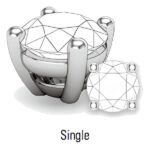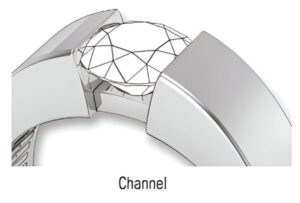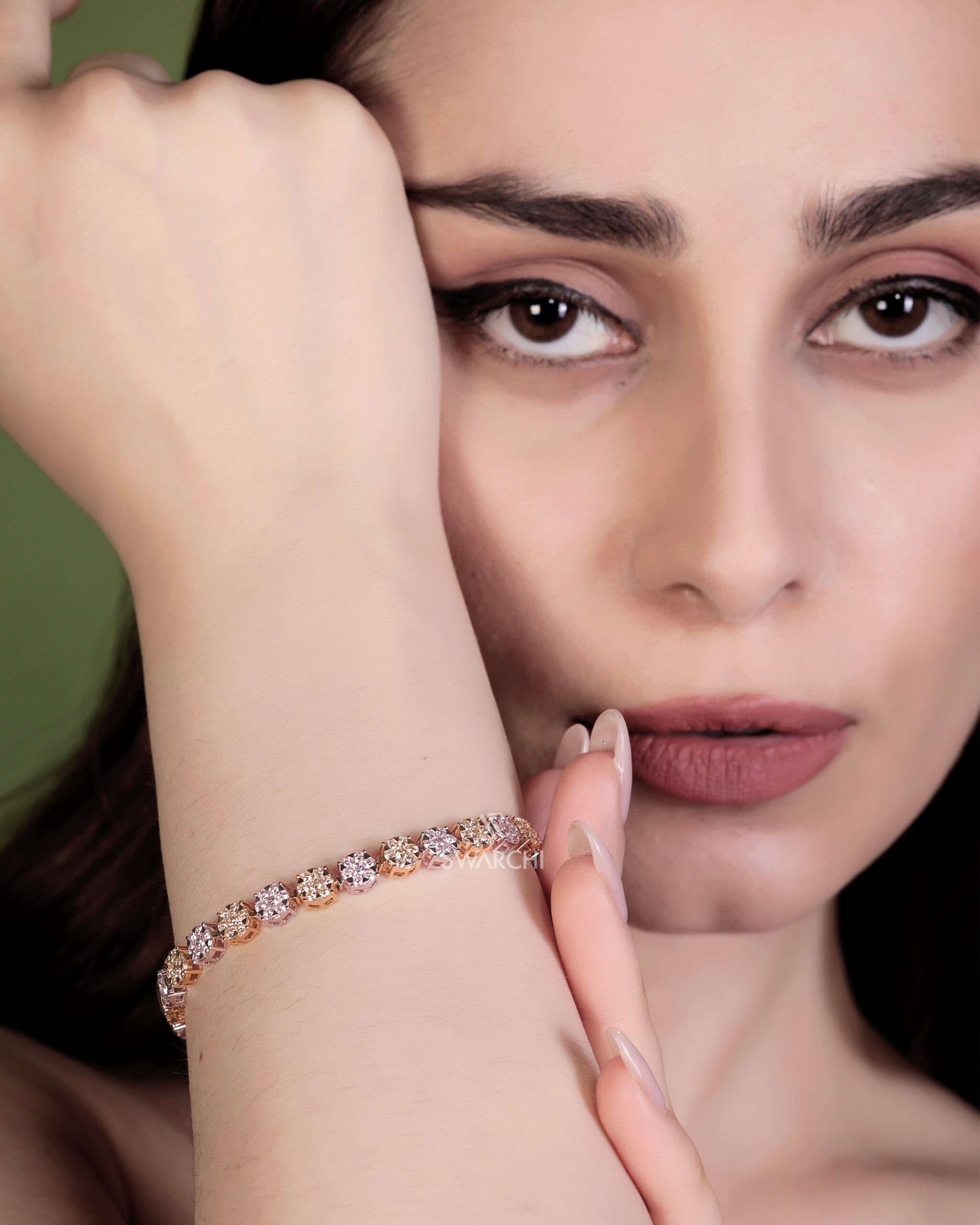Learn about different diamond setting types for custom jewellery. Get tips on choosing the perfect setting to match your style and enhance your diamond’s brilliance.
The type of setting you choose for your diamonds and gemstones make a huge difference in the look and style that your jewelry evokes.
With so many different setting types available, we’ve put together a complete guide of all the Diamond & Gemstone setting types. We also included what jewelry settings may work best with your lifestyle and stone.
Our examples are based on rings and bands. However, these settings work with all jewelry including earrings, necklaces, and bracelets.
These images allow you to see what each prong option looks like from the side as well as the top of the setting.
Prongs
Single Prong
First, and most commonly seen, is the single prong. The single prong is usually used at four points surrounding the stone and is flattened or rounded at the top.

Double Prongs
Next, is the double prong option placed at points securely surrounding the gem. This option obviously adds a little more metal around the stone which some people love and others find to be too much. It’s all personal preference.

Triple Prongs
Here you can see what the triple prong option looks like. Notice how it looks when viewing the gem from above.
Triple prongs give the setting a kind of starry quality. But again, some people love these design elements, and some prefer a more minimalist approach.

V-Prong or Chevron Prong
V-prongs, also known as chevron prongs, serve more than one purpose.
In addition to keeping your stone secure, this prong also helps protect your stone’s corners and points from damage.
Diamond cutters cleave a diamond to achieve the shape you see. And although diamonds may be the hardest stone in the world they can be accidentally cleaved or chipped when hit just right.
So, if you’re wanting a marquis or princess cut stone, the V-prong is the one you’ll want to use.

Decorative Double Prongs
Decorative prongs come to a point and some people like this look better than the more blunt-shaped prongs. Neither prong is more secure than the other. So, this is completely a style choice.
This example uses double prongs. However, the decorative point can be used with single or triple prongs as well.
Prongs For Looks & Security
It’s true, the look and design of your ring or jewelry are affected by the prongs surrounding your stones. But the prongs are very important to the security of your stones as well.
When deciding on the prong count and style you want to consider both looks as well as security. For example, stones with corners or points require specific settings to protect them from damage.
Consulting with a good jeweler will help you make the right decisions to protect your sentimental and financial investment. We’ve provided you with examples of several different options below.

Four Prongs Diagonally
Notice that these four prongs are located at the four points of a diamond shape. So, now the prongs are at the top, bottom, and sides instead of like the square of the four/standard positioning. Both examples are equally secure.

Standard or Four Prongs
One prong at each of four corners like a square is considered the Standard four-prong setting and is used quite often.

Six Prongs
Here we see six prongs which make the stone more secure. With two more prongs, you won’t have as big of a gap for your stone to fall through if one prong is damaged or yanked away.
In addition, six prongs help to secure and protect a large stone more effectively, giving you a little more peace of mind.

Eight Prongs
For obvious reasons, when it comes to prong settings the eight prong setting is the most secure. The more prongs, the more secure your diamond or gemstone will be.
Not only do eight prongs fill any gaps to fall through they also provide more barriers from the knocks of everyday life. So, instead of your gemstone being hit, you’re even more likely that it’s a prong that takes the hit.
However, remember there will be eight prongs coming down the sides (pavilion) of your stone. This means you’ll have extra metal affecting the design and look of your ring from the sides.

Two Prongs – Horizontal
Two prongs make a beautiful minimalist style that really shows off a gem to its fullest. This example is set on the horizontal with one prong on the left and one on the right.
However, two prongs are not going to be as safe and secure. Therefore, you probably want more prongs for a very valuable stone.

Two Prongs – Vertical
Our next example is another variation on two prongs but in the vertical format, one prong on top and one below. Again, this is a very cool minimalist look for a more modern style.

Basket Setting
Basket settings are perfect for protecting and securing round gemstones with undenied style.
From minimal to ornate, there are many variations on basket setting design. They’re highly popular and help protect the pavilion and the culet (sides and point) of your precious stones.

Peg Head Setting
Peg head settings usually have little or no ornamentation to distract from the gemstone.
They are made to highlight your stone and hold it up to the world allowing light to flow into the entire gem. Much of the time they are used to complement and protect large solitaire stones.
Sometimes the peg head is set down into the shank (band) and sometimes they sit atop the shank for extra height.

Decorative Setting
A decorative setting highlights a gem in a beautifully artistic way. Such decorative settings really complement the design of the entire piece of jewelry.
Notice how the setting protects the pavilion of the stone in this design. However, you can tell light will still come through the setting to make the gem sparkle.
A decorative setting can include any number of prongs.

Bezel Setting
For the ultimate protection, a bezel setting surrounds the entire stone.
In many jewelry examples, bezel settings can give a contemporary feel to a piece of jewelry. In addition, there are also more minimal bezel settings that are built around only the girdle (rim) of the gemstone.
Be aware, bezel settings are more difficult to construct than prong settings. Make sure you’re working with a skilled jeweler, especially if it’s the centerpiece of your jewelry.
Since they have no prongs bezel settings don’t catch on fabrics, important if you live an active lifestyle.

Half-Bezel Setting
A half-bezel is a variation on the bezel setting also known as the semi or partial bezel.
The half-bezel is exactly as the name implies, with this setting the bezel is vacant from around half of the stone allowing more light in.
This setting reveals a bit more of the stone as well and cuts down on the metal giving the jewelry a little bit different look than a full bezel.

Bright Cut Setting
A bright cut setting refers to a method of surrounding the stone with a small high-polished, bright-cut wall and holding it with bead prongs. Therefore, light reflects into the diamond creating more brilliance and making the stone appear larger.
In addition because the stone is set lower it protects the stone more.
In this example, the prongs are actually bead settings. Bead setting brings metal up from the base the stone is sitting in rather than adding additional metal.

Bridge Accent
A bridge accent adds a highlight to the arch in the setting beneath a stone.
In this example, a small round diamond accent adds interest and balances out a beautiful design giving it a more 3-dimensional effect.
It’s amazing how such a small design element can have such a considerable impact on your jewelry. Another popular option is adding a colored gemstone accent to a diamond engagement ring creating a gorgeous highlight.

Channel Set
A widely used setting for all types of jewelry especially bands and bracelets. Because of the technique used in channel setting we recommend that only the hardest stones be used, diamonds, rubies, and sapphires.
When channel setting a stone the jeweler cuts a groove (the channel) into the metal on each side of the setting. Next, the stone is carefully situated into the channels and the metal is adjusted along the stone to tighten it in place.
If the channel is too small the stone may break. If the channel is too large the stone may wobble in the setting. Again, a skilled jeweler is a must when executing a good channel setting.

Trellis Setting
The trellis setting uses prongs and is similar to a basket setting. However, the prongs are interwoven, overlapping, and crisscrossing with a lovely scrolling style giving the design a feeling of movement.
The trellis prongs are curved for a more flowing romantic style. Plus, you get more 3-dimensional interest since the trellis creates design elements on each side of the ring.
The trellis works equally well with a single stone or multiple stones, like the ever-popular 3-stone ring.

Sculptural Settings With Variations
Sculptural settings are narrow at the bottom and curve upward to fit around the gem, somewhat like a flower bud.
Above are some examples of the variations available in the sculptural style settings.
Stone Setting Styles For Bands & Bracelets
Using the same setting for a single stone will look very different when applied to a row of multiple stones.
Here we give you an idea of what to expect with settings when used in bands and bracelets or any jewelry utilizing rows of gemstones.

Channel Setting
Channel settings are very popular for multiple stones because of their clean look and their security. A word to the wise, it’s a good idea to have a sizing bar at the back of your channel set band.
A sizing bar is a place at the back of the band without a stone or a channel. It’s a small solid strip of metal only. Therefore, allowing a jeweler a place to size your band without damaging any stones or the integrity of your ring.
This will save you big bucks later down the road when a sizing is necessary.

Bright-Cut & Bead Setting
Bright-cut and bead settings are very popular for bands and bracelets and are sometimes referred to as pinpoint.
Remember, as with a single stone, bright cutting involves angled walls with a high-polish surrounding the stones. Therefore, reflecting light and color back upon the stones.
However, opposed to the channel set, with this setting you’ll have small prongs between each stone.

Surface Prong Setting
The surface prong setting has the stones sitting in a borehole on top of a solid metal band with a prong at the top and bottom of each stone. The prongs continue around the band in the same pattern to hold each stone in place.
Since these stones sit atop the metal they tend to get more light than channel and bright cut settings. However, they are not as secure as types that sit down in the metal which is even more important with bracelet designs since they tend to get more abuse.
When deciding on a setting be real with yourself about how hard you may be on your jewelry.

Shared Prong Setting
Shared prong settings have a separate setting for each stone with two pronounced prongs at the top and bottom corner of each setting. These two prongs then share with their partnering stone next door to hold each stone in place. This same pattern continues around the band. This setting would be more secure than the surface prongs but less secure than the channel or bright cut settings.

Bar Setting
A bar setting is similar to the channel set but with a groove (channel) cut into a vertical bar beside each stone instead of an entire rail across the top and bottom.
In addition, each stone is set into its own separate setting with each distinct bar on the east/west sides of the stone and continuing around the entire piece.
Just like in the channel setting, because of the technique, we recommend that only the hardest stones be used in bar settings, like diamonds, rubies, and sapphires. Definitely no brittle stones like emeralds.

Scallop Setting
Notice with the scallop setting how you see a U-shape cut out underneath each stone. Therefore, you get more light to the stones but still have some protection.
You can also more easily clean dirt out from underneath the stones which may be important to people who work in the medical field or have allergy problems.
This setting style also uses shared prongs but it doesn’t have the rail of metal all along the sides of the stones.

Fishtail Setting
Also similar to the scallop setting but here we have a wide divided prong that comes up to meet the stones. This wide split prong is where the name comes from because it looks like a fishtail or mermaid tail.
Fishtail settings give you more of a squared-off look. So, you’ll find they were very popular in the 1920s to 30s with their angular Art Deco styling and even well into the 1950s.
Often times the “tails” are designed with motifs that add immensely to the overall look of a piece. This legendary style continues its comeback.

Bezel Setting
A bezel setting is such a style standout! Is it mod or modern? Is it contemporary or retro? You be the judge.
Some bezels even have texturing, a brushed finish, or patterning giving the bezel more variety in its styling. And once again, the bezel setting is the best protection for your gemstones.
If you know you’re hard on your jewelry this might be the perfect setting for you.

Pavé Setting
The pavé setting is actually like a bead setting in multiple rows. The amount of metal is held to a minimum with each prong holding in three stones!
It’s the perfect answer for adding loads of bling. Pavé can also be used subtly as well with stunning results.

Gypsy Setting
The gypsy setting insets each stone into the metal so you have no prongs of any kind.
This is great for people who don’t want to worry about their jewelry catching on fabrics or anything else. It’s the perfect setting for people who have an active job or lifestyle.
Gypsy settings run the gamut with different styles as well. With a heavier squared-off style they look masculine. However, change it up with a rounded, softer look and they become a fun, feminine style.

Test Your Skills
Now if you’d like, check out our real-life examples from our inventory of rings and see if you can spot the different setting styles.
With so many options that differences and similarities quickly become confusing and overwhelming. Let us help you figure out which setting will be the best protection for your jewellery based on your desires and lifestyle.
Call or come by Swarchi Jewellery, Surat Gujarat and we’d be happy to educate you further or help you design a custom piece.


